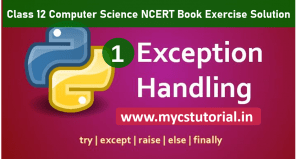Chapter 6 Societal Impacts NCERT Exercise Solution
1. After practicals, Atharv left the computer laboratory but forgot to sign off from his email account. Later, his classmate Revaan started using the same computer. He is now logged in as Atharv. He sends inflammatory email messages to few of his classmates using Atharv’s email account. Revaan’s activity is an example of which of the following cyber crime?
Justify your answer.
a) Hacking
b) Identity theft
c) Cyber bullying
d) Plagiarism
Answer: (b) Identity theft
Identity theft means obtaining someone’s credentials to commit some online fraud.
2. Rishika found a crumpled paper under her desk. She picked it up and opened it. It contained some text which was struck off thrice. But she could still figure out easily that the struck off text was the email ID and password of Garvit, her classmate. What is ethically correct for Rishika to do?
a) Inform Garvit so that he may change his password.
b) Give the password of Garvit’s email ID to all other classmates.
c) Use Garvit’s password to access his account.
Answer: a) Inform Garvit so that he may change his password.
3. Suhana is down with fever. So, she decided not to go to school tomorrow. Next day, in the evening she called up her classmate, Shaurya and enquired about the computer class. She also requested him to explain the concept. Shaurya said, “Mam taught us how to use tuples in python”. Further, he generously said, “Give me some time, I will email you the material
which will help you to understand tuples in python”.
Shaurya quickly downloaded a 2-minute clip from the Internet explaining the concept of tuples in python. Using video editor, he added the text “Prepared by Shaurya” in the downloaded video clip. Then, he emailed the modified video clip to Suhana. This act of Shaurya is an example of —
a) Fair use
b) Hacking
c) Copyright infringement
d) Cyber crime
Answer: c) Copyright infringement
4. After a fight with your friend, you did the following activities. Which of these activities is not an example of cyber bullying?
a) You sent an email to your friend with a message saying that “I am sorry”.
b) You sent a threatening message to your friend saying “Do not try to call or talk to me”.
c) You created an embarrassing picture of your friend and uploaded on your account on a social networking site.
Answer: a) You sent an email to your friend with a message saying that “I am sorry”.
5. Sourabh has to prepare a project on “Digital India Initiatives”. He decides to get information from the Internet. He downloads three web pages (webpage 1, webpage 2, webpage 3) containing information on Digital India Initiatives. Which of the following steps taken by Sourabh is an example of plagiarism or copyright infringement? Give justification in support of your answer.
a) He read a paragraph on “ Digital India Initiatives” from webpage 1 and rephrased it in his own words. He finally pasted the rephrased paragraph in his project.
b) He downloaded three images of “ Digital India Initiatives” from webpage 2. He made a collage for his project using these images.
c) He downloaded “Digital India Initiative” icon from web page 3 and pasted it on the front page of his project report.
Answer: b & c
Plagiarism means using someone else’s work without giving adequate citation for use and presenting as your own work.
Copyright infringement means using copyright-protected material without obtaining copyright holder’s permission or without paying for it, if it is being sold.
6. Match the following:
| Column A | Column B |
| Plagiarism | Fakers, by offering special rewards or money prize asked for personal information, such as bank account information |
| Hacking | Copy and paste information from the Internet into your report and then organise it |
| Credit card fraud | The trail that is created when a person uses the Internet. |
| Digital Foot Print | Breaking into computers to read private emails and other files |
Answer:
| Column A | Column B |
| Plagiarism | Copy and paste information from the Internet into your report and then organise it |
| Hacking | Breaking into computers to read private emails and other files |
| Credit card fraud | Fakers, by offering special rewards or money prize asked for personal information, such as bank account information |
| Digital Foot Print | The trail that is created when a person uses the Internet. |

7. You got the below shown SMS from your bank querying a recent transaction. Answer the following —
a) Will you SMS your pin number to the given contact number?
Answer : No, I will not shared PIN to that contact number.
b) Will you call the bank helpline number to recheck the validity of the SMS received?
Answer : Yes. I will call the bank helpline number.
8. Preeti celebrated her birthday with her family. She was excited to share the moments with her friend Himanshu. She uploaded selected images of her birthday party on a social networking site so that Himanshu can see them. After few days, Preeti had a fight with Himanshu. Next morning, she deleted her birthday photographs from that social networking site, so that Himanshu cannot access them. Later in the evening, to her surprise, she saw that one of the images which she had already deleted from the social networking site was available with their common friend Gayatri. She hurriedly enquired Gayatri “Where did you get this picture from?”. Gayatri replied “Himanshu forwarded this image few minutes back”.
Help Preeti to get answers for the following questions.
Give justification for your answers so that Preeti can understand it clearly.
a) How could Himanshu access an image which I had already deleted?
Answer: Images loaded on a social networking site can be saved/downloaded or even screenshots may be taken.
b) Can anybody else also access these deleted images?
Answer: Yes, from the digital footprint, government and other agencies can obtain these legally, if needed.
c) Had these images not been deleted from my digital footprint?
Answer: Images deleted from a social website always remain part of a digital footprint.
9. The school offers wireless facility (wifi) to the Computer Science students of Class XI. For communication, the network security staff of the school have a registered URL schoolwifi.edu. On 17 September 2017, the following email was mass distributed to all the Computer Science students of Class XI. The email claimed that the password of the students was about to expire. Instructions were given to go to URL to renew their password within 24 hours.

a) Do you find any discrepancy in this email?
Answer: Yes. If you look carefully, the url given in mail has one extra ‘i’. The original school URL is schoolwifi.edu , while URL given in mail is schoolwifii.edu/update password.
b) What will happen if the student will click on the given URL?
Answer: It is a phishing site which will steal the students’ data.
c) Is the email an example of cyber crime ? If yes, then specify which type of cyber crime is it. Justify your answer.
Answer: Yes. It is an example of phishing where using a similar looking URL and site , people are fooled.
10. You are planning to go for a vacation. You surfed the Internet to get answers for the following queries —
a) Weather conditions
b) Availability of air tickets and fares
c) Places to visit
d) Best hotel deals
Which of your above mentioned actions might have created a digital footprint?
Answer: All of these.
11. How would you recognise if one of your friends is being cyber bullied?
a) Cite the online activities which would help you detect that your friend is being cyber bullied?
Answer: Repeated posting of rumors’, giving threats online, posting the victim’s personal information, sexual harassment or comments aimed to publicly ridicule a victim.
b) What provisions are in IT Act 2000, (amended in 2008) to combact such situations.
Answer: The act provides legal framework for electronic governance by giving recognition to electronic records and digital signatures. The act outlines cyber crimes and penalties for them.
12. Write the differences between the following —
a) Copyrights and Patents
b) Plagiarism and Copyright infringement
c) Non-ethical hacking and Ethical hacking
d) Active and Passive footprints
e) Free software and Free and open source software
Answer:
(a) Copyrights and Patents
Copyright : A copyright is a collection of rights automatically vested to someone who has created an original work. The copyright owner has the authority to keep or to transfer the rights to use/distribute, individually to one or more people, or to transfer them collectively to one or more people.
Patent : A patent is a grant of exclusive right to the inventor by the government. Patents give the holder a right to exclude others from making, selling, using or importing a particular product or service, in exchange for full public disclosure of their invention.
(b) Plagiarism and Copyright infringement
Plagiarism : Plagiarism is stealing someone else’s intellectual work and representing it as your own work without citing the source of information.
Copyright infringement : Copyright infringement is the use or production of copyrightprotected material without the permission of the copyright holder.
(c) Non-ethical hacking and Ethical hacking
Ethical Hacking is done on behalf of a company, which wants to find out the loopholes in the system in context to security.
Unethical Hacking, on the other hand, is done in order to harm or cause loss to an individual or a company.
(d) Active Digital Footprint and Passive digital footprint
An active digital footprint includes data that you intentionally submit online, e.g., sending an email, sending messages online, posting a social media post, replying to post or commenting online etc.
A passive digital footprint gets created through your data trail that you unintentionally leave online. For example, when you visit a website, the web server may log your IP address, which identifies your Internet service provider and your approximate location.
e) Free software and Free and open source software
Free Software means the software is freely accessible and can be freely used, changed, improved, copied and distributed to others. No payments are needed to be made for free software.
Free and Open Source Software : refer to a software which is both free software as well as open source software. An open source means, it source code is also available.
13. If you plan to use a short text from an article on the web, what steps must you take in order to credit the sources used?
Answer: Following steps need to be taken
(i) Determine if you need the permission to use the desired piece of work.
(ii) Identify the owner of the article.
(iii) Identify the rights needed to use it.
(iv) Contact the owner and negotiate whether payment is required. (v) Get your permission agreement in writing.
14. When you search online for pictures, how will you find pictures that are available in the free public domain. How can those pictures be used in your project without copyright violations?
Answer: The images with Copyleft or Creative Commons licenses can be used without copyright violations. Hence we can search for images with such licenses.
15. Describe why it is important to secure your wireless router at home. Search the Internet to find the rules to create a reasonably secure password. Create an imaginary password for your home router. Will you share your password for home router with following people. Justify your answer.
a) Parents
b) Friends
c) Neighbours
d) Home tutors
Answer: WiFi router security is important otherwise any one can use our wifi to commit fraud or cybercrimes.
Rules to Create Secure Password:
- At least 8 characters—the more characters, the better.
- A mixture of both uppercase and lowercase letters.
- A mixture of letters and numbers.
- Inclusion of at least one special character, e.g., ! @ # ? ] Note: do not use < or > in your password, as both can cause problems in Web browsers.
We shall share the password with parente only.
Never share your wifi password to Friends, Neighbours and Home Tutors. There is possibilities that someone else also come to know your wifi password. If you shared in emergency, then don’t forget to change the password.
16. List down the steps you need to take in order to ensure —
a) Your computer is in good working condition for a longer time.
b) smart and safe Internet surfing.
Answer:
(a) Device Safety: Ensures Good Health of a Computer System:
(i) Regularly clean it to keep the dust off. Use a liquid solution specifically formulated for the cleaning of electronic screens.
(ii) Wipe monitor’s screen often using the regular microfibre soft cloth (the one used for spectacles).
(iii) Keep it away from direct heat, sunlight and put it in a room with enough ventilation for air circulation.
(iv) Do not eat food or drink over the keyboard. Food crumbs that fall into the gaps between the keys or spilled over liquid can cause issues to the devices.
b) Smart and Safe Internet Surfing:
(i) Download only from secure websites and official app stores.
(ii) Always type the URLs rather than using a webpage or email link.
(iii) Avoid clicking on unknown links.
(iv) Use regularly updated anti-virus software.
(v) Look for secure URLs (with https) while providing data or making payments.
(vi) Avoid using the proxy sites and proxy software.
17. What is data privacy? Websites that you visit collect what type of information about you?
Answer: Data privacy refers to the rules about the authorised access of data, i.e., which all users/sites/ service providers etc. can access or track the data/ browsing information.
Websites collect the following information :
(i) IP addresses of the user’s computer (user’s location).
(ii) Information about usage of website. For example, what users click on and how long they spend on a page.
(iii) Information about browsers and device used to access the sites.
(iv) Browsing activity across different sites.
18. In the computer science class, Sunil and Jagdish were assigned the following task by their teacher.
a) Sunil was asked to find information about “India, a Nuclear power”. He was asked to use Google Chrome browser and prepare his report using Google Docs.
b) Jagdish was asked to find information about “Digital India”. He was asked to use Mozilla Firefox browser and prepare his report using Libre Office Writer.
What is the difference between technologies used by Sunil and Jagdish?
Answer: Sunil used freeware while Jagdish used free and open source software.
19. Cite examples depicting that you were a victim of following cyber crime. Also, cite provisions in IT Act to deal with such a cyber crime.
a) Identity theft
b) Credit card account theft
Answer: (a) Someone got hold of login and password of our social network site and used it to troll or cyber bully someone using stolen credentials.
(b) Someone did fraud shopping after stealing our credit card.
20. Neerja is a student of Class XI. She has opted for Computer Science. Neerja prepared the project assigned to her. She mailed it to her teacher. The snapshot of that email is shown below.

Find out which of the following email etiquettes are missing in it. Justify your answer.
a) Subject of the mail
b) Formal greeting
c) Self-explanatory terms
d) Identity of the sender
e) Regards
Answer: Missing Email etiquettes are (a) , (b), (d)
(a) The shown email lacks a valid subject,
(b) A Formal Greetings are not mentioned like Good Morning, Dear Sir, Dear Friends, etc.
(e) No Regards mentioned in the mail.
21. Sumit got good marks in all the subjects. His father gifted him a laptop. He would like to make Sumit aware of health hazards associated with inappropriate and excessive use of laptop. Help his father to list the points which he should discuss with Sumit.
Answer: Excessive digital usage may lead to :
(i) Impact on bones and joints
(ii) Eye strain
(iii) Sleep issues
(iv) Mental health issues
(v) Internet addiction disorder
Class 12 Informatics Practices NCERT Book Exercise Solution
- Class 12 Informatics Practices Code 065 Ch 1 Querying and SQL Function – NCERT Book Solution

- Class 12 Informatics Practices Data Handling using pandas – I NCERT Solution

- Class 12 Informatics Practices Chapter 3 Data Handling Using Pandas – II NCERT Exercise Solution

- Class 12 Informatics Practices Unit 4 Plotting Data using Matplotlib NCERT Exercise Solution

- Class 12 Informatics Practices Chapter 5 Internet and Web NCERT Exercise Solution

- Class 12 Informatics Practices Chapter 6 Societal Impacts NCERT Exercise Solution

Class 12 Informatics Practices – Data Handling Using Pandas – I Multiple Choice Questions
Data Visualization – Plotting in Python MCQ’s
- Class 12 Informatics Practices Data Visualization using Python Matplotlib MCQ’s Set 1

- Class 12 Informatics Practices Data Visualization using Python Matplotlib MCQ’s Set 2

- Class 12 Informatics Practices Data Visualization using Python Matplotlib MCQ’s Set 3

- Class 12 Informatics Practices Data Visualization using Python Matplotlib MCQ’s Set 4

Class 12 Informatics Practices Societal Impacts Multiple Choice Questions
- 200+ MCQ’s Class 12 Informatics Practices Unit 4 Societal Impacts Set 1

- 200+ MCQs Class 12 Informatics Practices Unit 4 Societal Impacts Set 2

- 200+ MCQs Class 12 Informatics Practices Unit 4 Societal Impacts Set 3

- 200+ MCQs Class 12 Informatics Practices Unit 4 Societal Impacts Set 4

- 200+ MCQs Class 12 Informatics Practices Unit 4 Societal Impacts Set 5

- 200+ MCQs Class 12 Informatics Practices Unit 4 Societal Impacts Set 6

- 200+ MCQs Class 12 Informatics Practices Unit 4 Societal Impacts Set 7

- 200+ MCQs Class 12 Informatics Practices Unit 4 Societal Impacts Set 8

- 200+ MCQs Class 12 Informatics Practices Unit 4 Societal Impacts Set 9

- 200+ MCQs Class 12 Informatics Practices Unit 4 Societal Impacts Set 10

Class 12 Computer Science : NCERT Exercise Solutions
- Interface Python with MySQL – Important Questions – Answer
- Class 12 Computer Science – Exception Handling in Python NCERT Exercise Solutions

- Class 12 Computer Science File Handling in Python NCERT Exercise solution

- Class 12 Computer Science Stacks NCERT Exercise Solution

- Class 12 Computer Science Queues NCERT Exercise Solution

- Class 12 Computer Science Sorting NCERT Exercise Solution
- Class 12 Computer Science Chapter 8 Database Concepts NCERT Exercise Solution

- Class 12 Computer Science Structured Query Language SQL NCERT Book Exercise Solution

- Class 12 Computer Science Ch 10 Computer Network NCERT Book Exercise Solution

By Anjeev Kr Singh – Computer Science Educator
Published on : September 18, 2021 | Updated on : February 5, 2022























